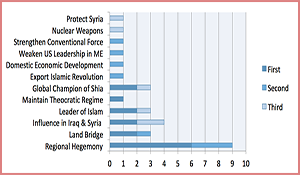
Promoting Greater Stability in Post-ISIL Iraq, Volume 2
Promoting greater stability in post-ISIL Iraq, Volume 2: Why do groups form and why does it matter for stability in Iraq? When the social becomes political. Author | Editor: Bragg, B., & Polansky (Pagano), S. (NSI, Inc.) Executive Summary United States Central Command (CENTCOM) posed the following question to the Strategic Multi-layer Assessment (SMA) virtual […]
Continue Reading
Prioritized Iranian Interests in the Middle East
Question (R6.9): How does Iran prioritize its influence and presence in the region? Author | Editor: Canna, S. (NSI, Inc). Executive Summary Hoping to answer the question of how Iran prioritizes its influence and presence in the Middle East, we asked fifteen experts to list—in rank order—Iran’s key interests, how it seeks to realize those […]
Continue ReadingPopulation’s Positive View of ISIL
To what extent do populations maintain positive views of ISIL or ISIL’s ideology, particularly in European, N. African, and Arabian Peninsula countries most associated with foreign fighter flows into Syria and Iraq? What are the general perceptions associated with ISIL endorsed themes, to include: 1) desire for re-establishing the Caliphate; 2) imposition of Shariah law; […]
Continue ReadingCounter Extremism in Sunni Communities
Question (V2): What are the key factors that would impact the wave of violent extremism and ideological radicalism that affect the Sunni community? Author | Editor: Canna, S. (NSI, Inc). Executive Summary The Sunni community is not homogenous, and contributors expressed their discomfort making broad generalizations for a number of reasons. Most Sunni Arabs still […]
Continue ReadingCounter-Messaging to Prevent Radicalization
Question (R6.4): Knowing that religion is only one (and not the most important) stimulus for disgruntled Islamic youth to join VEOs, what could/should be the domestic messaging to youth to prevent their “radicalization” and joining the VEOs? To what extent could a continued presence of Western military in the Middle East (even only as instructors/trainers) […]
Continue Reading
How to Position USG Against a Long Term ISIL Threat
What long-term actions and processes should U.S. government (USG) institutions, the Coalition and the international community examine to position ourselves against a long term ISIL threat? How can the private sector be effectively engaged by government institutions to optimize the effects needed for success? Executive Summary Expert contributors agree that terrorism will remain a long-standing […]
Continue ReadingWhole of Government Approach to Conflict
R4 Question #2: How could DoD and DoS be better postured to address regional and world conflicts to ensure a whole of government approach to identify and synchronize lines of effort in both planning and execution? Author | Editor: Canna, S. (NSI, Inc). Executive Summary Not many experts were willing to tackle this problem of […]
Continue ReadingIraq: Coalition or Bilateral Approach?
Question (R6.3): What is most favorable for the stability and the future of Iraq after the defeat of Da’esh: continued presence of an international Coalition or normal state-to-state bilateral relations? If a Coalition is the preferred option, what could be the “unifying factor” for a post-OIR coalition in Iraq and what situations could exist/emerge to […]
Continue ReadingNew Iran Strategy
Question (R6.6): How does USCENTCOM, working within a whole of government approach, coordinate military operations in support of the change in approach towards Iran from the previous to the current administration? Author | Editor: Jafri, A. (NSI, Inc). Executive Summary As battlefield successes actualize, decision makers have an opportunity to align tactical and operational policies […]
Continue Reading
Building Partner Capacity: Iraq
Question (R6.10): What can the U.S. and Coalition partners realistically do to enable Iraqi Security Forces (ISF) to combat a long-term ISIS insurgency? Recognizing the enormous resources the U.S. poured into the ISF from 2003 until 2011, only to see much of the force collapse in 2014, what can we do to avoid making the […]
Continue Reading